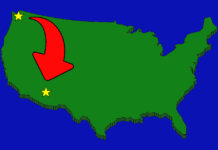Not everyone has raptors on their guest list, but when Cub Scout Pack #977 met this week, they had guests of a winged variety. These guests, who concluded a month-long theme on Birds of a Feather, came attired in those feathers, with polished talons and sharpened beaks. They included a Red Tailed Hawk, a Turkey Vulture and a Great-Horned Owl.

Cub Scout Kyle Thacker salutes the flag during the traditional presentation of the colors, which started the meeting.
Tuk Jacobson is a biologist from the Arizona Game and Fish Department’s Non-Game Branch. His specialty is Bald Eagles, and, working for the Game and Fish Department, he spends his days searching for and documenting findings of Bald Eagle nests. Jacobson gave the Cub Scouts a presentation on Bald Eagles, including some interesting facts that many of the boys didn’t know.
For example, did you know that Bald Eagles are born grey? They don’t develop their familiar coloration until age five. Another interesting fact that the pack learned was that Bald Eagles typically nest around water because around 80% of their diet is made up of fish.

Biologist Tuk Jacobson, of the Arizona Game and Fish Department’s Non-Game Branch, presented facts and information about Bald Eagles.
Volunteers Claudia Kirscher and Max Bessler from Liberty Wildlife, a rehabilitation, education and conservation organization for Arizona wildlife, brought three raptors for the boys to see and learn about.

Acoma, a Red-Tailed Hawk, came to the conservation when he ran into a window and broke both wings; now he can’t fly.
Raptors are classified as birds of prey because they hunt and eat meat with beaks and talons. The three raptors brought for viewing were Acoma, a Red-Tailed Hawk, Bailey, a Turkey Vulture and Magellan, a Great-Horned Owl. The three birds have been imprinted, meaning they were at the conservation at a certain developmental period in their lives when they otherwise would have been taught how to fend for themselves. Since they were at the facility for medical purposes, these particular birds did not learn how to be birds of the wild and, therefore, cannot be released. All three are used for educational purposes and travel around with handlers, helping to teach about their own characteristics as well as a general respect for nature.

Max Beesler from Liberty Wildlife holds Bailey, a Turkey Vulture who was born at the Phoenix Zoo.

This ”Tiger of the Sky,’ better known as a Great-Horned Owl, is Magellan. A favorite food of Great-Horned Owls is skunk, due to the raptors’ lack of smell.
Tuesday night’s Cub Scout meeting definitely had a unique guest list. Not only was the night educational, it was also a hit with the Cub Scouts as well as their leaders. “I think it was thrilling for the boys to see up close the birds they have been studying,” explained Cub Scout Leader Gloria Bonnell.
For more information on Cub Scouting or becoming a member, contact Bonnell by email or by phone at (520) 568-2995.

![Province writer opens the athlete’s mind in new book Tom Schuman, a Province resident, poses with a copy of his new book, "My Wide World of Sports," outside his home on May 2, 2024. [Monica D. Spencer]](https://www.inmaricopa.com/wp-content/uploads/2024/05/spencer-050224-tom-schuman-sports-book-web-01-218x150.jpg)







![Maricopa’s ‘TikTok Rizz Party,’ explained One of several flyers for a "TikTok rizz party" is taped to a door in the Maricopa Business Center along Honeycutt Road on April 23, 2024. [Monica D. Spencer]](https://www.inmaricopa.com/wp-content/uploads/2024/04/spencer-042324-tiktok-rizz-party-flyer-web-218x150.jpg)

![City gave new manager big low-interest home loan City Manager Ben Bitter speaks during a Chamber of Commerce event at Global Water Resources on April 11, 2024. Bitter discussed the current state of economic development in Maricopa, as well as hinting at lowering property tax rates again. [Monica D. Spencer]](https://www.inmaricopa.com/wp-content/uploads/2024/04/spencer-041124-ben-bitter-chamber-property-taxes-web-218x150.jpg)
![Maricopa restaurateur makes Food Network connection [Namkeen Dhaba]](https://www.inmaricopa.com/wp-content/uploads/2024/04/439456716_377105198650519_7536248579664805896_n-218x150.jpg)
![O’Reilly gears up for second Maricopa location An exterior view of O'Reilly Auto Parts on John Wayne Parkway on May 2, 2024.[Monica D. Spencer]](https://www.inmaricopa.com/wp-content/uploads/2024/05/spencer-050224-oreilly-second-location-web-100x70.jpg)
![Province writer opens the athlete’s mind in new book Tom Schuman, a Province resident, poses with a copy of his new book, "My Wide World of Sports," outside his home on May 2, 2024. [Monica D. Spencer]](https://www.inmaricopa.com/wp-content/uploads/2024/05/spencer-050224-tom-schuman-sports-book-web-01-100x70.jpg)

